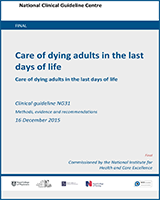| Qualitative studies |
|---|
| Dendaas 200229 | Individual interviews | n=15, nursing staff from hospices and inpatient oncology units who had recent experiencing of caring for multiple oncological patients in the last days of life.
USA | To ascertain how experienced oncology nurses described the dying process of people with advanced cancer with relation to its length, recognisability using key signs and symptoms, and whether it is monitored. | A standard interview with open questions was developed but not all questions asked to all applicants. Reliable methods of analysis including external groups to transcribe the interviews and another group of experts to code the interviews were used. |
| Johnson 200351 | Individual interviews with set open questions | n=8 junior doctors with limited experience of intensive care medicine discussed their care of a person (the person had to be a current inpatient. If the person had either died or been discharged the discussions were excluded from analysis).
USA | To discuss with junior doctors their recent experiences on prognosis and how they approach care decisions when caring for seriously ill hospitalised people. | The people discussed by the junior doctors were not necessarily recognised in the last days of life by the junior doctor, although they were prompted to consider whether they might die. There was no information provided on the time of death of the people discussed. |
| Van Der Werff 201299 | Focus group design | n=18 nursing staff that had recent experiencing of caring for an oncological patient in the last days of life.
Netherlands | To assess nurse perspectives on the signs and symptoms that suggest oncological patients are entering the last days of life. | A small study but good methodology on analysis. Study aimed to focus on oncological patients but this was not reflected in the example stem questions the facilitator of the focus group used. |
| Surveys |
|---|
| Abarshi 20111 | Retrospective survey design with closed and open questions. Self-reported. | n=251. General practitioners who had looked after people in the last 3 months of their life (includes details of last 1 week of life).
Netherlands | To explore the factors that allow primary care physicians to recognise that someone is entering the last days of life, and how this relates to care during this period. | Multivariate analysis undertaken, taking into account the person demographics. The study included an indirect population as all deaths over 1 years were included and were grouped together with younger adults (1-64 years) forming 20% of the study population. |
| Domeisen 201332 | Delphi survey | n=252 Nurses, physicians, psycho-social-spiritual professionals, volunteers and carers from 9 participating countries:
Switzerland, Italy, Netherlands, Sweden, Germany, UK, Argentina, New Zealand, and Slovenia. | To describe the most pertinent phenomena in identifying whether a person is in the last hours or days of life from any condition. | The population of experts for the Delphi included both the multiprofessional team and lay members but not for all rounds of the Delphi. The different rounds had different populations and it wasns't clear how these were formed. |
| Brandt 200513 | Prospective observational study | n=474 All long term nursing home care people assessed by physicians to be entering the last 6 weeks of life. Other inclusion criteria included admittance to nursing home for long term care or admitted for rehabilitation but during their stay it became obvious that the person would not leave the nursing home.
Netherlands | To examine the dying person in nursing home settings, in particular the patient characteristics and signs that lead physicians to recognise entering the last 6 weeks of life. It also aims to look at the relationship between specific underlying disease and these symptoms with categories of cardiovascular disease, mental/behavioural disorders, and malignant neoplasms. | The doctors were asked to enter people into the study when they believed they were in the last 6 weeks of life. Even though this is indirect from the protocol looking at the last days of life, the majority of the people who were included had died by day 9 of the study. |
| Christakis 200022 | Prospective survey design | n=468 people were discussed with 343 doctors who estimated their likely time of death. The actual date of death was then later collated from national records.
USA | To investigate factors (such as optimism, and pessimistic and medical experience) that affect doctors' prognostication of people in outpatient hospice settings. | Included an indirect population- the median survival was 24 days of the people included. |
| Kumagai 201254 | Delphi survey | n=72 community palliative nurses who had experience in looking after people who had died from either lung or gastrointestinal cancer.
Japan | To identify predictors of the last 10 and 3 days of life in people with lung, gastric, or colorectal cancer at home. | The methods were well described with a good use of existing literature to formulate the initial Delphi. There was poor response rate in the study. The study only focuses on symptoms from 2 particular conditions. |
